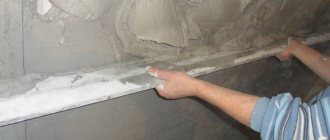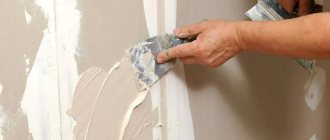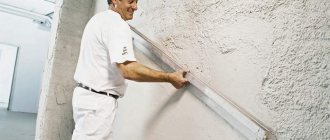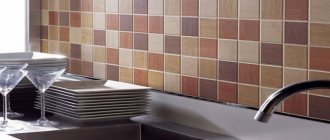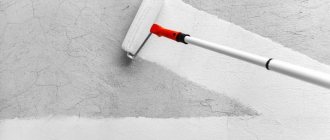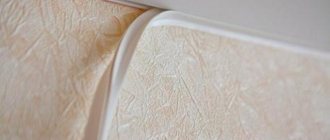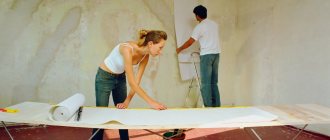A practicing designer talks about materials that hide unevenness
Usually everything happens like this: after measurements at the site, the customer and I begin to discuss the technical specifications of the design project. One of the questions is whether it is expected to save on geometric alignment of the walls during repairs (a substantial amount). I explain the pros and cons of each option. And if I understand that the client is inclined to visually align the walls, then I make a note to myself: solutions should be proposed taking into account the possible curvature of the walls. After all, not everything that looks great on a geometrically flat surface is suitable for a “cluttered” wall.
Related article: How to choose wallpaper for painting on walls
Important:
In this article I will tell you what techniques you can use to mask small unevenness-differences within the acceptable limits. If the difference is 10 cm, nothing but gypsum board or a Rotband truck will help the walls.
__________________________ IN YOUR CITY...
Find a designer in your city on Houzz - order your own project
__________________________
1. Non-woven wallpaper
Why only non-woven ones? - Only they can somehow be pulled, stretched, adjusted on the wall. Don’t expect an ideal result: when pasted on an uneven wall, the wallpaper will diverge at the seams somewhere and overlap somewhere. In the second case, skilled craftsmen cut off the excess - they make a visual continuation of the joint, cutting off parts of the wallpaper that fall on top of each other. If you do it yourself and don’t know the technique, the only fate is to turn a blind eye to uneven seams.
2. Silk wallpaper from a jar
They are only called wallpapers. In fact, this is not a roll, but a material in a can, which is applied to the wall with a spatula. Application is not difficult - even a beginner can do it.
To the touch it is a dense, warm, silky coating, sometimes textured, sometimes smoother. The texture depends on the fillers. The composition includes cellulose, silk fibers, minerals, quartz, decorative additives, and may contain additives against mold or mildew. The material has no seams.
This kind of liquid wallpaper can be applied to uneven walls; it will hide all the imperfections of the walls.
3. Cork sheets
There is an opinion that you can stick sheet cork on the wall and thereby hide the unevenness of the wall. It's a delusion. Sheet cork is actually large format tiles. And I recommend using them if only one wall is “cluttered” in the room (cut sheets can be covered with a curtain, for example).
Covering all the walls in the room with cork and thereby hiding unevenness is out of the question. The wall will not become smoother, the joints will be visible, and the same problems will arise as when gluing wallpaper. Moreover, the gluing technology does not allow you to move or adjust the sheet of cork on the wall - the glue sets immediately. In terms of price, the material is not at all budget-friendly, I certainly won’t recommend it to those who want to save money on wall leveling (the cost of “Rotband”).
4. Facade plaster
Such types of decorative plaster as smooth, even, velvety, silky require ideal walls. These options can be safely crossed out.
However, for uneven walls it is quite possible to use facade plaster indoors. It has a larger grain and structure. Yes, it looks very simple, but if the interior style allows it, then why not.
5. Decorative plaster with coarse grain
Alternatively, you can try lime plaster. If, during the process of shrinkage of the house or operation, cracks and chips appear, it will look like a continuation of the original idea, and not a tragedy. Plaster with various additives such as pieces of mica, vermiculite - the so-called decorative waste - will help enhance the effect.
Please note that with the low price of the material, “application” can be a serious cost item - it is often necessary to hire a specialist with a narrow specialization. If saving was the main motive for not leveling the walls, decorative plaster is unlikely to be a reasonable way to save money. But if you wanted to save time and start finishing as soon as possible, then yes, perhaps you can try.
7. Paint
Of course, uneven walls can simply be painted, first using a primer
-
directly over the plaster. There is also paint that looks like decorative plaster. It is slightly denser in composition than usual and is applied not with a roller, but with a spatula. Ideally, it is used on a leveled, prepared surface, but you can try applying it to an imperfect wall.
Advice:
Do not buy material for the entire room at once. Buy a small sample jar and experiment.
8. Wooden dies
Make the walls wooden? Yes, no leveling is required. The well-known lining, decorative timber and all kinds of wooden elements will come to your aid.
Related article: How to cover a brick wall in an apartment
10. Living wall
A technique that is suitable for a fragment of an (accent) wall. For example, in a situation where we don’t want to level the wall in the bathroom. This is understandable - bathrooms are usually tiny and “eating” even 5 cm of leveling is usually an unaffordable luxury. But it is also impossible not to level - tile seams and trimming that diverge in the corners will unmistakably indicate walls without leveling.
Which exit? Make a panel (perhaps even in the shape of a trapezoid, rather than a regular rectangle). But lay the tiles along its edges perfectly evenly. Perfectly hides defects in a phytowall or a moss wall: suitable for wet rooms, does not require maintenance. But after a few years the plants will have to be completely replaced.
YOUR TURN….
What do you use to mask uneven walls at your clients’ properties? If you did the repairs yourself, without geometric alignment, what coating did you use? Share in the comments
Cover with wall panels or clapboard
If you choose volumetric panels, there is no need to level the walls. On sale you can easily find many interesting solutions imitating wood, stone, brick or in the form of textured abstractions.
If the interior style is country or you like eco-friendly materials, it is appropriate to use lining painted in any suitable shade.
Another advantage of panels and lining is additional sound insulation.
Hiding uneven walls: 7 tips
Tip #1. Hide defects under wallpaper
If you have an uneven wall, then you should abandon plain wallpaper. Give preference to non-woven or vinyl wallpaper that has an active pattern. Such wallpapers have a high density, embossing and multi-layering. Thanks to this, small wall defects will be easy to hide.
Tip #2. Turn a disadvantage into an advantage
An uneven wall doesn't have to be a problem. Use this flaw as a highlight of your interior. For example, the loft style is great for combining incongruous things. In it, concrete and brick walls are adjacent to expensive antique or modern furniture. So why trim something that could be a great decorative element? Of course, this option is suitable for those who like this style, but take this idea into account.
Tip #3. Choose an unusual material.
An unusual decor for the apartment will be a wall decorated with cork panels. You can handle the installation yourself without additional help - the wall surface does not require careful preparation, as with other types of finishing. Cork comes in a variety of shades and textures - it will definitely add variety to your interior.
Tip #4. Use wood panels
Wooden panels will not only help hide the unevenness of your walls, but will also give an original and stylish look to your room. Natural materials are quite expensive, but you can use panels that are decorated like wood. True, this technique is only suitable for spacious rooms, otherwise your small space will look even smaller.
Tip #5. Switch your attention to decor
In order to divert attention from the unevenness of the wall, you can use various volumetric decor, for example, posters or paintings. Place the decor where the defects are most visible. This solution will be very convenient if you suddenly want to change something after a while.
Tip #6. Emphasize irregularities
Play on the imperfections: some people use decorative plaster to create irregularities - and you already have them. Proper lighting will help enhance the effect and emphasize the relief of the walls - ceiling and spot lighting, spotlights, as well as wall lighting from below.
Tip #7. Don't be afraid to experiment
If you don't mind bold decisions, then uneven walls can be painted dark blue or black. Of course, such an interior will not suit everyone, but to prevent the dark color from looking too depressing, use some popular design techniques. For example, avoid pointing lights at walls, as the black color will absorb light. The rays, on the contrary, should come from the walls: choose lighting fixtures that can be hidden under plasterboard structures or “recessed” in a niche. Don't neglect bright decorative elements - they will enliven dark walls.
If you find an error, please select a piece of text and press Ctrl+Enter.
Hide behind liquid wallpaper
This material is sold dry or ready-made and applied to the wall using a spatula. Wallpaper comes in a variety of shades and can be textured in appearance or smooth and silky.
They contain cellulose, minerals and various decorative additives. One of the main advantages is the absence of seams. When applied, they smooth out wall imperfections.
Products with bright patterns
A bright, rich and intense pattern is best; it will help hide all imperfections. Since when using plain trellises, all irregularities will be emphasized. Therefore they should be avoided. Abstract drawings that are randomly located on the surface have proven themselves especially well. They distract and attract the eye. As practice shows, it is better to use small patterns on the surface, for example, images of flowers or monograms. But, it is better to buy wallpaper that does not require selection of a pattern, so that the joints do not highlight the unevenness on the wall even more.
As for geometric patterns, they are not suitable for hiding irregularities. After all, the curvature of the walls will only stand out more as a geometrically even figure, straight lines will be distorted and will immediately catch the eye.
Work technology: preparation of the base and gluing
In order to glue the prepared material with sufficient quality, it is necessary to prepare the surface well. To do this, the plane is cleaned of dust and the cracks are sealed. If this is not done, the wallpaper may tear in the future, especially for paper types. Be sure to apply a primer, otherwise the glue will be absorbed into the wall before it has time to set.
The glue is applied to the canvas, then it has time to be absorbed into the base. An exception may be non-woven types; in order to make the process faster, glue can be applied to the surface of the partition. In order not to emphasize the defects in the base of the canvas, it is better not to smooth it, as is usually done, but to roll it with a wide roller, bypassing the depressions. The gluing process begins from the corner located near the window if the overlapping method is used and from any angle when the gluing is used end-to-end.
Advice. If the canvases are glued end-to-end on uneven substrates, to eliminate the divergence of the seam, the wallpaper is overlapped, followed by trimming the edges. You can also paint the surface at the joints in the color of the wallpaper, then the unraveling seam will not be so visible.
This is how you can join the canvases
How to hide crooked walls: 5 effective ways
Curvature and uneven walls are found not only in old houses, but also in new buildings.
Read the article about effective ways to hide this flaw. Smooth walls are convenient because they look perfect and allow you to install built-in furniture without any problems. But leveling walls requires special skill from repairmen and large investments. If you need to save money and don’t want to spend a lot on professionals and materials, then below are five ways to visually hide the curvature of the walls.
“Level” with façade plaster
For most interiors, decorative plaster is considered the most suitable: it cannot be called budgetary, and besides, it is not suitable for leveling.
To hide wall defects, give preference to façade mixtures with coarser grains: after application, the surface becomes embossed and rough. Suitable for styles where simplicity and texture decorate the interior: country, Provence, Scandinavian, loft.
